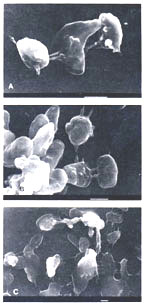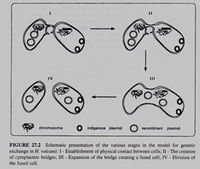Haloferax
A Microbial Biorealm page on the genus Haloferax

Classification
Higher order taxa:
Archaea, Euryarchaeota, Halobacteria, Halobacteriales, Halobacteriaceae, Haloferax
|
NCBI: Taxonomy Genome |
Description and Significance
Haloferax volcanii is a species of halophile which exists in extreme saline environments. Recently an isolate of this species was studied by researchers at University of California-Berkeley as part of a project on the survival of haloarchaea on Mars. Like other halophiles, Haloferax volcanii has been isolated in high-saline environments, most commonly the Dead Sea, the Great Salt Lake, and oceanic environments with high NaCl concentrates.
Genome Structure

Haloferax volcanii's genome consists of a large (4 Mb), multicopy chromosome and several megaplasmids.
Haloferax volcanii's genome has officially been completely sequenced, however it is not yet available in full in annotated form. The molecular biology of H. volcanii has been extensively studied for the last decade in order to discover more about DNA replication, DNA repair and RNA synthesis. The archaeal proteins used in these processes are extremely similar to Eukaryotic proteins and so are studied primarily as a model system for these organisms. Haloferax volcanii undergoes prolific horizontal gene transfer both with Archaea and, to a lesser extent, bacteria.
Cell Structure and Metabolism
Reproduction among Haloferax volcanii occurs asexually by binary fission. This practice is similar to that of other Archaea and, indeed, that of bacteria.
H. volcanii cells have no cell wall and, like many archaea, therefore use their exterior S-layer for structure. They are typically recognisable by their 'dished crisp' shape, but are soemwhat pleiomorphic so may be seen in other shapes including coccoid. The membranes of this organism are made of the typical ether linked membrane lipids found solely in archaea and also contain a high level of carotenoids including lycopene, which gives them their distinctive red colour.
H. volcanii use a salt in method to maintain osmostasis, rather than the typical compatible solutes method seen in bacteria. This method involves the maintenance of a high degree of K+ ions in the cell to balance the Na+ ions outside. for this reason H. volcanii has a complex ion regulation system.
Due to the salt in method cytoplasmic proteins are structured to fold in the presence of high ionic concentrations. As such they typically have a large number of charged residues on the exterior section of the protein and very hydrophobic residues forming a core. This structure increases their stability in saline and even high temperature environments considerably, but comes at some loss of processivity compared to bacterial homologs.
H. volcanii respire as their sole source of ATP, unliek several other halobateriacae, such as Halobacterium salinarium they are incapable of photphosphorylation as they lack the neccessary bacterioruberin.
Ecology

Isolates of Haloferax volcanii are commonly found in high-salinity aquatic environments, such as the Dead Sea. Their precise role in the ecosystem is uncertain, but the proteins contained within these organisms potentially serve many practical purposes. Because of their ability to maintain homeostasis in spite of the salt around them, Haloferax volcanii could be an important player in advancements in biotechnology. As it is likely that Haloferax volcanii and comparable species are ranked among the earliest living organisms, they also provide information related to genetics and evolution.
References
Allers, Thorston. Research Interests. School of Biology, University of Nottingham.
DasSarma, Shiladitya et al. Halophiles. Halobacterium Genome Project, University of Maryland.
Redkar, Rajendra J. et al. The Haloferax volcanii Genome Project. Microbial Genome Program Section.
